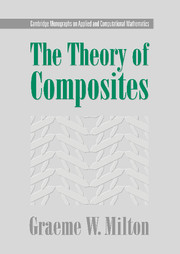Book contents
- Frontmatter
- Contents
- List of figures
- Preface
- 1 Introduction
- 2 Some equations of interest and numerical approaches to solving them
- 3 Duality transformations in two-dimensional media
- 4 Translations and equivalent media
- 5 Some microstructure-independent exact relations
- 6 Exact relations for coupled equations
- 7 Assemblages of spheres, ellipsoids, and other neutral inclusions
- 8 Tricks for generating other exactly solvable microgeometries
- 9 Laminate materials
- 10 Approximations and asymptotic formulas
- 11 Wave propagation in the quasistatic limit
- 12 Reformulating the problem of finding effective tensors
- 13 Variational principles and inequalities
- 14 Series expansions for the fields and effective tensors
- 15 Correlation functions and how they enter series expansions†
- 16 Other perturbation solutions
- 17 The general theory of exact relations and links between effective tensors
- 18 Analytic properties
- 19 Y-tensors
- 20 Y-tensors and effective tensors in electrical circuits†
- 21 Bounds on the properties of composites
- 22 Classical variational principle bounds
- 23 Bounds from the Hashin-Shtrikman variational inequalities
- 24 Bounds using the compensated compactness or translation method
- 25 Choosing the translations and finding microgeometries that attain the bounds†
- 26 Bounds incorporating three-point correlation functions†
- 27 Bounds using the analytic method
- 28 Fractional linear transformations as a tool for generating bounds†
- 29 The field equation recursion method†
- 30 Properties of the G-closure and extremal families of composites
- 31 The bounding of effective moduli as a quasiconvexification problem
- Author index
- Subject index
8 - Tricks for generating other exactly solvable microgeometries
- Frontmatter
- Contents
- List of figures
- Preface
- 1 Introduction
- 2 Some equations of interest and numerical approaches to solving them
- 3 Duality transformations in two-dimensional media
- 4 Translations and equivalent media
- 5 Some microstructure-independent exact relations
- 6 Exact relations for coupled equations
- 7 Assemblages of spheres, ellipsoids, and other neutral inclusions
- 8 Tricks for generating other exactly solvable microgeometries
- 9 Laminate materials
- 10 Approximations and asymptotic formulas
- 11 Wave propagation in the quasistatic limit
- 12 Reformulating the problem of finding effective tensors
- 13 Variational principles and inequalities
- 14 Series expansions for the fields and effective tensors
- 15 Correlation functions and how they enter series expansions†
- 16 Other perturbation solutions
- 17 The general theory of exact relations and links between effective tensors
- 18 Analytic properties
- 19 Y-tensors
- 20 Y-tensors and effective tensors in electrical circuits†
- 21 Bounds on the properties of composites
- 22 Classical variational principle bounds
- 23 Bounds from the Hashin-Shtrikman variational inequalities
- 24 Bounds using the compensated compactness or translation method
- 25 Choosing the translations and finding microgeometries that attain the bounds†
- 26 Bounds incorporating three-point correlation functions†
- 27 Bounds using the analytic method
- 28 Fractional linear transformations as a tool for generating bounds†
- 29 The field equation recursion method†
- 30 Properties of the G-closure and extremal families of composites
- 31 The bounding of effective moduli as a quasiconvexification problem
- Author index
- Subject index
Summary
This section presents a sampling of general techniques for using solutions of the conductivity or elasticity equations in a given microgeometry to generate associated solutions in related microgeometries. In addition to the methods discussed here, it should be mentioned that conformal transformations are useful for finding exact solutions for the fields, in particular, two-dimensional geometries: See Berdichevskii (1985), who found the exact solution for the fields in a regular checkerboard geometry; Obnosov (1996, 1999), who obtained the explicit solution for rectangular and triangular checkerboards, as well as for certain rectangular arrays of rectangles at a volume fraction of 1/4; the many papers of Vigdergauz referred to in section 23.9 on page 481, who found various periodic microstructures where the field was constant within one phase; and Reuben, Smith, and Radchik (1995).
Modifying the material moduli so the field is not disturbed
Consider the formula (7.13) for the effective bulk modulus k* of the coated sphere assemblage. It does not depend on the shear modulus µ1 of the core material. The physical reason for this is quite clear: Under an externally applied hydrostatic loading the displacement field (7.11) in the core of each coated sphere is a pure dilation with no shear component, and so the effective bulk modulus is not influenced by the shear modulus of phase 1. This is an example of a more general principle, which says that if we modify the material moduli in any way that leaves the field undisturbed, then the response of the composite to that average field will remain unchanged.
Information
- Type
- Chapter
- Information
- The Theory of Composites , pp. 143 - 158Publisher: Cambridge University PressPrint publication year: 2002
